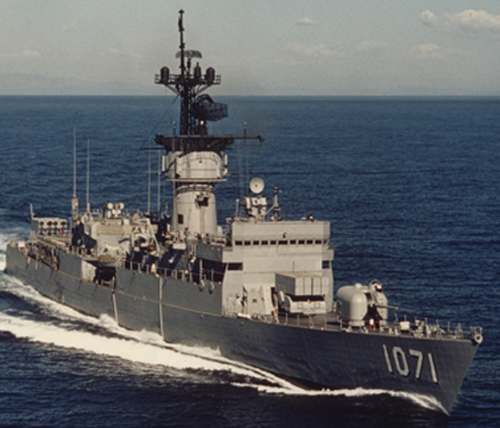|

The Prairie-Masker System was installed on Destroyer Escort class vessels (reclassified Fast Frigates - 1975) and was classified sercret. If you take a close look at the following picture you will notice two vertical lines (belts) on the Badger's starboard side. It almost looks like two pipes running up the hull from the waterline to her main or 01deck. One is even with the Mack and the other is located further aft. These belts ran the circumference of the hull and came up the other side to an equal point. This is the Masker piece of the system.
The other piece was the Prairie System. The fire room had two special air compressors for this system. They were low pressure (about 12 to 14 psi) but very high volume (1200 cu. ft. per minute). They ran off steam and ran at 44,800 RPM! The system was designed to use a blanket of air to mask the ship's machinery noise. The Masker System pumped air out of the belts that banded the hull as seen in this picture, and was what BTCM Jim Taylor was inspecting during the 72-73 overhaul. This would mask most machinery noise from Aux. 1, the fire room, and the engine room while sonar techs were listening for submarines. The Prairie System pumped the same air through Badger's shaft from the engine, out the point of the screw hub, and the blades of her screw were hollow and she had tiny holes at the leading edge of each screw blade that exuded bubbles to mask the noise from the screw. As mentioned above, the system was very secret for many years and worked very well. The only potential problem that arose during operations was if a major speed change occurred. For example; if the engineers received a sudden STOP bell or a bell to reverse speed they had to shut down the Prairie-Masker System immediately. Otherwise, the bubbles being generated by the Prairie-Masker compressors would be drawn into the cooling water inlets for the Main (main engine) and Auxiliary (generators) condensers which would would cause a loss of vacuum that would stop the ship and lose all electrical power. This information was provided by John Hudson, BTCS USN (Ret.)
|




